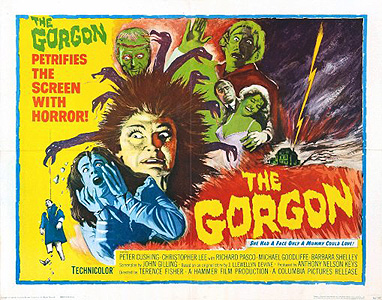 This Hammer House of Horror production features two of the studio’s biggest stars, Christopher Lee and Peter Cushing, and one of its top directors, Terence Fisher. Those things, however, don’t necessarily make for one of Hammer’s better pictures!
This Hammer House of Horror production features two of the studio’s biggest stars, Christopher Lee and Peter Cushing, and one of its top directors, Terence Fisher. Those things, however, don’t necessarily make for one of Hammer’s better pictures!
Terence Fisher was perhaps Hammer’s key director from its early pre-horror 1950s era, during which time Fisher directed the Hammer productions THE FOUR-SIDED TRIANGLE (1953), MASK OF DUST (1954) and STOLEN FACE (1952), which is often credited as the first stab at the type of horror that would come to define the studio. Later Fisher directed Hammer productions include THE CURSE OF FRANKENSTEIN (1957), DRACULA (1958), THE MUMMY (1959) and THE DEVIL RIDES OUT (1968).
Fisher’s THE GORGON (1964) was scripted by fellow Hammer vet John Gilling (who went on to direct the GORGON-esque Hammer production THE REPTILE in 1967). It was considered a disappointment in its day, as it concentrated more on character development than the shock effects of Fisher’s earlier horror efforts. Yet nowadays it’s extremely highly regarded by Hammer fans.
In a secluded village sometime in the early 1900s, Bruno Heitz, a rakish young man, dies under mysterious circumstances—and is later found turned to stone. His father Jules enters the village to discover what happened, and is himself turned to stone; Jules, however, writes a three page missive before dying, referring to a gorgon afoot in the area. A gorgon is a mythological creature whose gaze is so hideous it can turn people to stone.
Paul, the brother of Bruno and son of Jules, travels to the village to investigate. He meets the seductive Carla, the assistant to the mysterious Dr. Namaroff. Paul falls hard for Carla, who remains strangely aloof.
During a stormy night lit by a full moon Paul glimpses a horrific creature and passes out. He comes to five days later, in the care of none other than the abovementioned Dr. Namaroff. The latter is nonchalant about Paul’s night out, of which Paul remembers only that he glimpsed the most horrible creature he’d ever seen. He becomes determined to track down that creature, which he’s convinced is the mythological gorgon, while falling deeper in love with Carla. It doesn’t occur to him, however, that the two might be connected!
Paul enlists the services of the Van Helsing-esque Prof. Karl Meister. It’s Meister who deduces that Carla is the Gorgon Paul glimpsed, having been transformed into such by the full moon. The love-struck Paul refuses to believe him, though, and all-but rushes into a final confrontation with the gorgon and her keeper, Dr. Namaroff.
According to Christopher Lee, “The only thing wrong with THE GORGON is the gorgon!” He’s referring the title character’s less-than-convincing appearance. I feel he’s wrong about the film overall (there are actually quite a few things wrong with it), but correct regarding the gorgon’s tacky appearance—a woman in a green dress with rubber snakes on her head! Not that this matters overmuch, as the emphasis isn’t on gore or special effects.
It’s clear Terence Fisher was aiming for a quality film far removed from the usual Hammer schlock; this isn’t to say that Fisher in any way ignored the hoary melodrama so integral to Hammer films, just that he toned it down several notches. Noble intentions to be sure, but the problem is the characters Fisher was seeking to develop aren’t especially deep or interesting, and the narrative far too silly to sustain such an A-list treatment. Nor do the stars Peter Cushing and Christopher Lee (who could have used more screen time) do much to elevate the film.
There are a couple memorable moments. The protagonist’s initial encounter with the half-glimpsed gorgon in a moonlit windstorm is definitely a standout, as is the final showdown. But even a film like this needs more than just two good scenes to work.
Vital Statistics
THE GORGON
Columbia Pictures/Hammer Film Productions
Director: Terence Fisher
Producer: Anthony Nelson-Keys
Screenplay: John Gilling
Cinematography: Michael Reed
Editing: Eric Boyd Perkins
Cast: Christopher Lee, Peter Cushing, Richard Pasco, Barbara Shelley, Michael Goodliffe, Patrick Troughton, Joseph O’Conor, Prudence Hyman, Jack Watson, Redmond Phillips, Jeremy Longhurst
